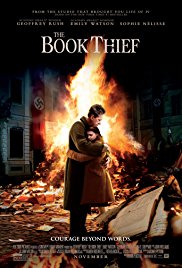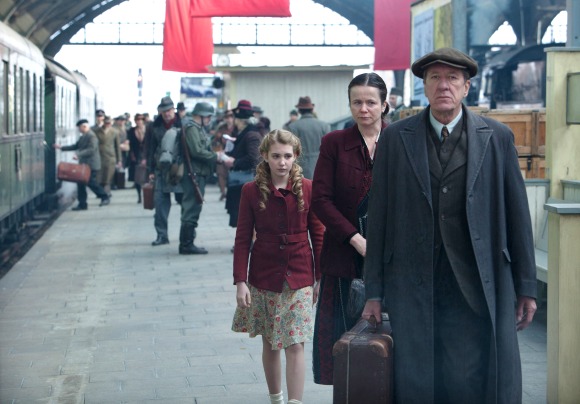6. A commentator wrote that, “Without ever denying the essential amorality and randomness of the natural order, The Book Thief offers us a believable, hard-won hope.” What is that hope?
Suggested Response:
The hope is that people can survive terrible circumstances and still have lives filled with love, as Liesel did. All the loving people in the novel embody that hope: Hans, Rosa, Rudy, the Mayor’s wife, and especially Liesel. Liesel becomes someone so alive and giving that even Death cannot help but love her and while Death may not be obsessed with them Hans, Rosa, and Rudy are memorable characters that all human readers/moviegoers will come to love. The quote is from Fighting for Their Lives by John Green, New York Times, May 14, 2006
7. Liesel is an admirable character, but there is something she did in this story that she will regret all her life. What was it and how does it relate to a major theme of the story?
Suggested Response:
Liesel will regret not allowing Rudy to kiss her; in other words, not allowing Rudy to express how much he loved her. And also not being able to tell him how much she loved him. The theme that this relates to is the positive power of love (Item C in the suggested response to question #1 in the Learning Guide). Of course, Liesel’s refusal was innocent and totally appropriate for a girl her age. It was only in light of Rudy’s unexpected and sudden death that it could be seen as an error.
8. The following two questions should be asked together:
A. What is the reason for Liesel’s brother, Hans, Rosa, and Rudy to die and for Liesel and Max to live?
Suggested Response:
There is no reason. Death is random.
B. This story suggests how to respond to the random dreadfulness of death. What does it tell us?
Suggested Response:
The only way to respond to the random dreadfulness of death is through a commitment to life and with love for the living.
9. In reality, is death-haunted by human beings? Why is the personification of death, the narrator of this story haunted by humans?
Suggested Response:
Death (the verb) is a process. Death the noun is a result. (p. 6). In reality, death has no feelings. However, as a literary device, as a narrator, “Death” must care about humans. Otherwise, the story would be flat and boring. But most importantly, Death is haunted by human beings because a theme of the book is that despite dreadfulness and inevitability of death, the human spirit triumphs over all; and in fact, as human beings, we need to believe that and we should believe it.
10. Several characters in the story suffer from survivor’s guilt in this story. What is survivor’s guilt and how do the characters deal with it.
Suggested Response:
Survivor’s guilt can occur when a person survives a traumatic event and others do not. Survivors will sometimes feel guilty as if they have done something wrong, when, in fact, they were just lucky or smart. Hans suffers from survivor’s guilt because he was the only person in his unit to survive an engagement. Hans, a man who understands the importance of love, takes his guilt and uses it to learn to play the accordion and to help Max. The son of Ms. Hostapfel commits suicide. Max feels guilty that he was happy to be alive when he left his family, most of whom undoubtedly were murdered by the Nazis. We are not really told how he deals with that but Death comments that he felt it all his life.
11. The novel contains the following passage at page 65:
Some crunched numbers. — Since 1933, ninety percent of Germans showed unflinching support for Adolf Hitler. That leaves ten percent who didn’t. Hans Hubermann belonged to the ten percent.
Consider this passage in relation to the one below from a novel called The Magus by John Fowles.
The human race is unimportant. It is the self that must not be betrayed. I suppose one could say that Hitler didn’t betray his self. . . . But millions of Germans did betray their selves. That was the tragedy. Not that one man had the courage to be evil. But that millions had not the courage to be good. (The Magus, p. 132)
As a member of a society, what do these passages mean to you? Do you think that Hans did enough to resist Hitler?
Suggested Response:
There is evil in every society. These passages tell us that we cannot stand idly by and allow our society to do terrible things. We must do what we can to enhance the good and restrain the evil. There is no good response to the question of whether Hans did enough to resist Hitler. A few Germans did resist the Nazis and paid for their actions with their lives. See The White Rose.
Personification of the All-Seeing Narrator
12. What was the benefit to the story that the narrator was a personification of death?
Suggested Response:
There are many; here are some examples. Students will probably come up with their own. (a) Using Death as a narrator allows the author/filmmakers and the reader/viewer to look at the lives and deaths of the characters from a vantage point that is something other than just being human. Since one of the important themes of the story is a celebration of the human spirit and of the human capacity for love and survival even through horrific circumstances, having Death be in awe of that spirit, haunted by humans as he says in the last words of the book and the film, allows the author to celebrate the human condition without appearing overly proud. In addition, the events of the story are so terrible that Death, as a non-human (a “result” as he says) can discuss them dispassionately, whereas a human observer would not be able to do this. Death’s lack of human feeling allows the reader/viewer to supply the emotion and in doing so, the reader/viewer can feel the emotion more exquisitely. (b) Having Death as a narrator is also a clear foreshadowing that important characters will die and allows explicit foreshadowing in the novel and the film. (c) Using Death as the narrator provides the opportunity for one of the chief ironies of the story, i.e., that death, which will eventually conquer all people and deprive them of their humanity, is obsessed with humanity especially by the character and strength of a little girl. (d) Using Death as a narrator immediately elevates the story to one that involves important questions of the human condition. (e) Having Death as the Narrator allows for numerous interesting ideas to be presented. Two examples are set out below:
One small fact: you are going to die. Despite every effort, no one lives forever. Sorry to be such a spoiler. My advice is when the time comes, don’t panic. It doesn’t seem to help.
It’s always been the same. The excitement and rush to war. I met so many young men over the years who have thought they were running at their enemy, when the truth was, they were running to me.
13. Death has different reactions to the souls of the people that it takes in the story. What do those reactions have in common?
Suggested Response:
Death’s reaction is very human and life-affirming. This is the essence of personification and one of the central ironies of the story.
14. In this story, death is personified, that is, it is given human characteristics despite the fact that it is not human; it’s a process (as a verb) or a result (as a noun). What is your reaction to that character?
Suggested Response:
There is no one correct answer. Some may say that they feared him. Others may say that he was wise. Some may say that he was cynical. Others may refer to his sense of humor. Still others may say that he was ludicrous.
15. Is the personification of Death as presented in this story a helpful concept?
Suggested Response:
There is no one correct answer. A good discussion will include the idea that it is not helpful in life because it doesn’t matter to Liesel or to us that death is haunted by humans. Death is cold, hard and the taking of our humanity. Another good point is that it is an overly romantic concept. Others may say that it gives them a sense of comfort even though it is a fantasy. [Teachers can further ask, “Why is that?” The answer is that we are human beings and we are afraid of death. The idea that death takes account of our actions is part of the idea that the universe takes account of our actions and that is comforting; since we are all going to die.]
16. Why are Liesel and her wonderful book spared?
Suggested Response:
Chance, only chance.
Symbol
17. Identify two symbols in this story.
Suggested Response:
Each of these symbols can be described in different ways. They include:
-
- Heaven Street: This is the name of the street on which the major characters live. It is the street where Liesel found love and happiness, where she learned to read, and where she started writing. With all the other problems that Heaven Street had, at least it gave her that and that was her source of happiness, i.e., it was heaven.
- Books, Words, Reading: There are a number of ways to describe this. Books and the ability to read are the means to salvation, literally, Liesel is saved because she went to the basement the night of the bombing to write her memoirs. Liesel is able to calm the people in the bomb shelter by using words: telling them a story or reading from a book. In the novel she does the same for Frau Holtzapfel. Death, who is haunted by humans, reads Liesel’s memoirs many times, i.e., life asserts itself over death through Liesel’s book, as Markus Zusak does through his book. Max is saved by his use of Mein Kampf to divert suspicion when he is traveling. Hans is saved when he is chosen to write some letters rather than go into the battle in which his platoon is decimated. Writing is a bell-weather for relationships. When Liesel’s mother doesn’t write back, she knows she’s dead. Liesel’s relationship with Frau Hermann, the Mayor’s wife, is based on books and it is Frau Hermann who gives Liesel a home after the bombing. Michael Holtzapfel explains his decision to take his own life in writing. However, books are also the means by which Hitler seduced the German people, as symbolized by the book Mein Kampf. So, it could be said that books, words and reading symbolize power for good or for evil.
- The Accordion: The accordion represents the best of Hans. It was given to him by Erik Vandenberg, the man who saved his life. Playing the accordion is a source of joy and comfort for Hans and for Hans’ audience. Rosa holds it to her breast and sleeps with it when Hans is away. It is a constant reminder and reaffirmation of his promise to Max’ father; complying with that promise, at great risk to himself and his family, ennobles Hans. One of Max’s first words to Hans when he shows up at the Hubermann’s door is, “Do you still play the accordion?” When Hans returns from military duty, somewhat broken after his experiences, it is difficult for him to play.
- Bread: In this story, bread is the staff of life, its archetypical meaning. However, when the Hans (in the novel) and the children (in the movie) give it to starving Jews it is more than that. It is respect and honor; an acknowledgment that they are human beings worthy of respect. This is why in the novel the old man kneels before Hans as, in the Zusak family story, the old man kneeled before the boy who gave him bread.
- The Snow Ball Fight and the Snow Man: These are a symbol for life. We have to do it and in the end it all melts away. Hopefully, we’ll have a great time in the process like the Hubermanns, Liesel and Max.
- The Grave Digger’s Handbook is the first book that Liesel uses to learn to read. Since reading is life for Liesel the name of her first book is an ironic symbol for that fact.
- The pages of Hitler’s Mein Kampf are whitewashed to become the pages of Liesel’s book.
Irony
18. List some instances of situational in the story.
Suggested Response:
Note to teachers: This story has ironic elements but the irony is not nearly so pervasive as the irony in other stories, such as Cyrano de Bergerac. A non-exhaustive list of ironies is set out below.
-
- Death being haunted by life, “usually, people are haunted by the fear of death;”
- Death has typical affectionate human reactions to each of the people whose souls he gathers; Death, however, is an impersonal process which results in the loss of human life and all that is human;
- Max, the Jew, uses a volume of Mein Kampf as a shield to avoid detections as he travels incognito in Germany;
- It is the pages of Mein Kampf, whitewashed by Max, that are the pages that Liesel uses to write her book;
- Rudy, the blue-eye, blond haired, perfect Aryan type is obsessed by Jesse Owens, a black athlete;
- Liesel who starts out not knowing how to read is saved by writing;
- Liesel is not supposed to be in the basement – she’s supposed to be upstairs in bed; but she lives because she’s in the basement;
- Liesel survives in a basement that was deemed too shallow to be an adequate shelter; Max also survives in that basement but not from an air raid;
- Hans’ life was saved when his friend Erik Vandenberg nominated him to stay back from the engagement and write letters for an officer; however, Hans wasn’t so good at reading and writing himself (obviously Mr. Vandenberg had more in mind than a good person to write letters when he suggested that his friend Hans stay back from the engagement — one would like to think that Mr. Vandenberg knew that Max was a good and loving soul who would do good in the world);
- The Mayor, the leader of the book burners, has a library full of books.
- The beginning of Liesel’s salvation is through The Grave Digger’s Handbook;
- The name of the first book that Liesel reads, the book on which she first learns to read, is The Grave Digger’s Handbook; since, for Liesel, reading is life, it is ironic that the book that Liesel uses to learn how to live is called The Grave Digger’s Handbook.
Other Literary Elements – Miscellaneous Questions [for students reading the book]
19. In the novel, Death is obsessed with color. Why does this make sense?
Suggested Response:
Death is the absence of color (bleached bones, entropy, etc.), and the way that a personification of death that was fascinated with life would react is that it would be attracted to color.
20. Max told Liesel that, “Memory is the scribe of the soul.” What figure of speech is this. What was Max trying to get at.
Suggested Response:
This is metaphor, a description enhanced by the comparison of unlike things. It is a beautiful thought. It is hard to say exactly what it means: one possibility is that our souls are made of memories, or that memory is the way that our souls work.
21. There are many instances of foreshadowing in this book. How does this author use foreshadowing?
Suggested Response:
He uses it to keep interest. The foreshadowing is always vague in many respects, and we want to read on to see how it turns out. Foreshadowing occurs on at least the following pages. 30, 33 & 34,55, 71, 80, 127, 128.
22. The voice of this story has two interesting aspects. One is that it is told from the standpoint of people who were the enemy in WWII, who we bombed, and who we tried to kill. The second is that it is told from the perspective of death. How does this dually foreign point of view add to the story?
Suggested Response:
The first is that it teaches one of the great themes of the story, which is that even among a hated and feared enemy there are people of character. The events of the story are too fraught with emotion to tell it from form Liesel’s point of view, or that of Hans, Rosa, or Rudy or any human character. The distance of death from human concerns allows the author/filmmakers to tell the story and then let the human reader/audience feel the emotions themselves. Also, having death as a narrator provides wonderful opportunities for thematic comment, imagery, etc.
See Discussion Questions for Use With any Film that is a Work of Fiction.






